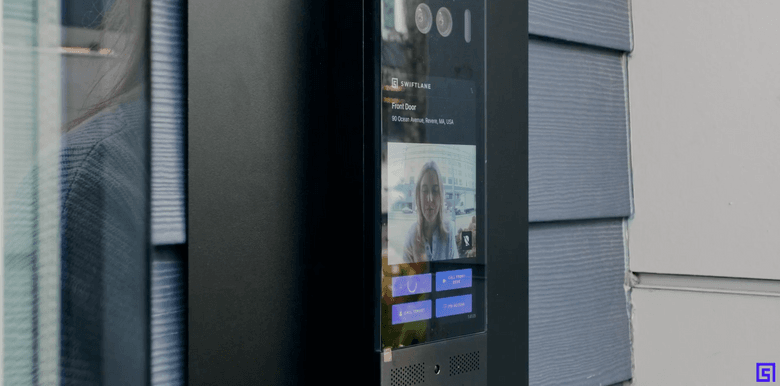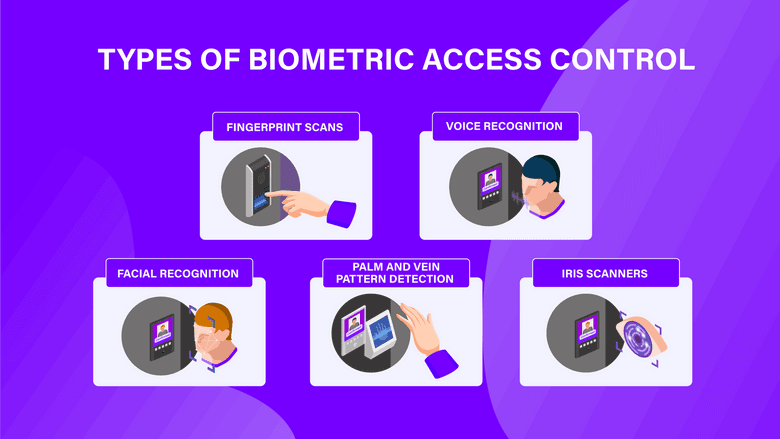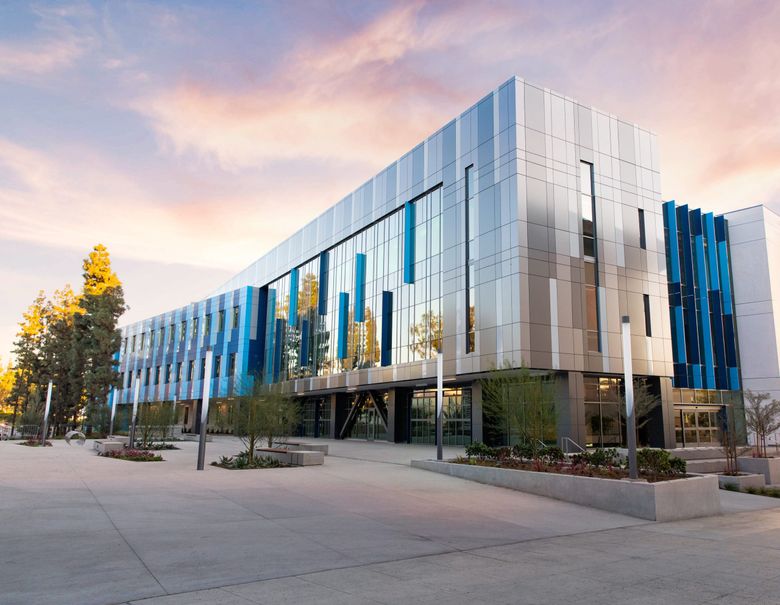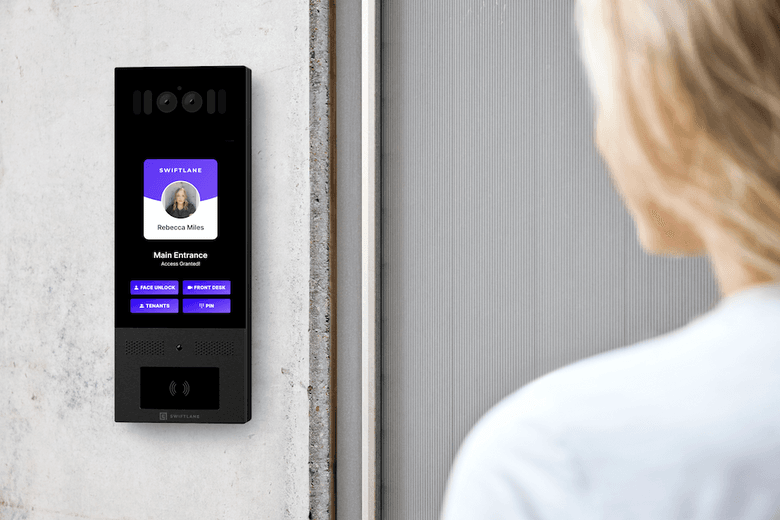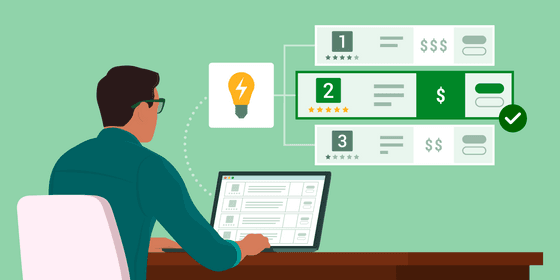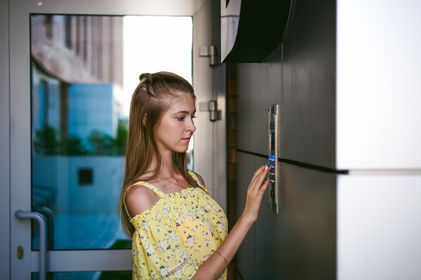Biometric access control systems are no longer just for high-security government facilities or sci-fi movies. They’re a smart, secure way to manage who gets in. You’ll find them deployed in more places than you might think.
From businesses to institutions to residential buildings and salon suites, biometrics offer a modern way to keep spaces safe, organized, and accessible to the right people.
Let us introduce you to biometric access control. We’ll explain who benefits, outline different versions, and illustrate how it can be used as an access control solution for residential and commercial buildings.
Table of Contents
- Introduction to Biometric Access Control Systems
- Types of Biometric Access Control
- Why Security Systems Turn to Biometrics
- Top Benefits of Biometrics for Buildings
- Who is Biometric Access Control For?
- Swiftlane for Biometric Building Access Control
- Frequently Asked Questions
Suggested Posts
- Best Intercom Systems (2025) – Top Picks for Every Type
- Salon Suite Access Control: The Ultimate Guide for Owners
- IP Intercom Systems and Why Your Property Needs One
Introduction to Biometric Access Control Systems
Biometric access control systems are security systems that use a person’s unique physical or behavioral characteristics to grant or deny access to a location, account, device, or system.
Instead of using keys, passwords, PINs, or access cards, they identify people based on traits that are difficult to fake or steal. These traits are unique to each person, like a fingerprint, the sound of a voice, or the shape of a face.
Here at Swiftlane, we focus primarily on building access control, so our world intersects with biometrics in tools like biometric door locks and biometric door access control systems in multitenant buildings. Those systems can include building intercoms and other devices that scan biometric features to grant building access. We focus on door, gate, and elevator unlock mechanisms for buildings. However, biometric access tools can be applied to computer systems, bank accounts, credit cards, and web or app logins.
Types of Biometric Access Control
Fingerprint Scans
Fingerprint scanning is an incredibly popular and widely used form of biometric access control for personal devices.
The fingerprint is a fairly unique personal identifier that is not easy to spoof. This is a much less popular option for building access control in multitenant buildings because many fingerprints must touch the same device for it to work. For multi-tenant buildings, “touchless” forms of biometric access are preferred.
Iris Scanners
Iris scanners read the colored part of the eye, which, like fingerprints, has a unique pattern for all individuals. It’s a highly accurate form of access control.
Often seen in sci-fi films, it is also expensive and, therefore, not widely deployed outside high-security institutional settings. Meanwhile, since users typically have to rest their chins on a pedestal close to a mounted camera during the retina scan, it is not considered “touchless,” which means it is best for systems with small numbers of users.
Palm and Vein Pattern Detection
Palm and vein pattern detection is a great new method where a camera or scanner records the unique pattern across an entire hand. Some systems require the hand to be placed on a reader, while others use a camera and are “touchless.”
While it may be touchless, it is not a “hands-free” method for access control. This means it can’t be used, for instance, when people are carrying things in both hands. Some tenants prefer the convenience of a biometric access method that is both touchless and hands-free, like the following.
Voice Recognition
Voice recognition analyzes the timbre and patterns of your speech to authenticate your identity. Some companies, such as Apple, briefly used it to unlock digital devices.
However, this method has fallen out of favor for high-security applications because voices are easier to spoof than other biometric IDs. Also, if a microphone is mounted in a noisy environment, such as the front door on a busy city street, it won’t work well for a building intercom system.
Facial Recognition
Facial recognition has become the go-to approach for biometric access control for Apple (patented Face ID technology), Android smartphones, and many building intercoms. It works fast – it can often identify one face every second.
It’s both touchless and hands-free, so it’s sanitary and works when people need to unlock a door while carrying items. This method became quite popular for doors after the COVID-19 pandemic, when people wanted touchless capabilities.
Special Considerations for Face ID: Older facial recognition systems could be spoofed by showing a photograph of a person to the camera. You must look for anti-spoofing technology, such as a 3D face detector or infrared sensor that ensures a live human is at the camera, not an image.
Also, some older systems were not well programmed to deal with the full diversity of faces and had trouble identifying people of color. Newer systems have improved on this with very low false identifications.
Why Security Systems Turn to Biometrics
You’re probably already familiar with biometrics, such as using your face or fingerprint to unlock a smartphone or log into an app or website. Biometrics are popping up everywhere, from the TSA and border control at airports to computer terminal log-ins and as a form of building access.
Biometric access control eliminates the need to carry or remember physical keys, passwords, PINs, QR codes, or other digital access devices, which can be easily forgotten, lost, or stolen.
Unlike traditional methods, biometrics ensures that only authorized individuals can gain access since the credentials cannot be transferred or misused.
Top Benefits of Biometrics for Buildings
Enhanced Security: Biometrics are hard to replicate and nearly impossible to share, reducing the risk of unauthorized access by people who don’t belong in the building. Meanwhile, building occupants and staff are loaded into the system, who quickly gain access by presenting their unique biometric credentials, such as their face or fingerprint.
Convenience: There is no need to remember passwords or carry access cards unless two-factor authentication is used.
Multifactor authentication: Biometrics can be part of multi-factor authentication (MFA), where two or more methods of proving one’s identity are required. For instance, a numeric PIN can be entered alongside facial ID or a fingerprint read as a double form of identification.
Audit Trail: Building security systems can log exactly who accessed what and when, improving traceability beyond the use of anonymous keys, keyfobs, or PINs that anyone can use.
No key “leakage”: Building tenants may share their PINs, keys may be copied, and even RFID key fobs can be cloned. Over time, building security weakens because so many keys and access codes are floating about. Using a biometric key means that only authorized users can unlock the door, and keys don’t proliferate.
No lockouts: Building managers spend inordinate time dealing with lockouts and forgotten keys. With biometric systems, the authorized tenant always has their own key available.
Who is Biometric Access Control For?
In building access control, biometrics can solve several key problems for property managers and tenants and provide clear benefits for different building types (e.g., commercial, institutional, residential).
Biometric Access Control for Commercial Buildings
For businesses, keeping things secure without slowing people down is vital. That’s where biometric access really shines.
- Process traffic quickly with systems like facial recognition gates in building lobbies, which can also sync with elevator access control systems. Protect sensitive areas like server rooms or executive offices.
- Use it as part of a multi-factor setup—combine biometrics with a PIN or keycard for extra security.
- Scale effortlessly as your team grows or changes—no need to reissue badges or reset passcodes.
- Track employee hours accurately without swipe cards or punch-ins.
Whether you’re running a small office or a large facility, biometric access control is a smart investment.
Biometric Access Control for Institutions and Campuses
Places like hospitals, schools, and government buildings need reliable access control that balances safety and ease of use.
- In healthcare, biometrics can help limit access to things like medication storage or patient records, and help keep operations HIPAA compliant.
- In schools and universities, it keeps classrooms, labs, and even dorms more secure.
- In government or research facilities, it ensures that only authorized personnel get through to sensitive areas.
It’s about creating safer spaces without slowing down the people who belong there.
Biometric Access Control for Residential
Home security is getting smarter—and biometric access is part of that evolution. It’s helping residential property managers deal with the increasing volume of traffic to their properties (from deliveries, nannies, dog walkers, house cleaners, etc.) while also keeping packages and building occupants safe.
- Ditch the keys and use a fingerprint or facial scan to get into your home, or condo/apartment building.
- In apartment buildings or multi-unit properties, it’s a great way to simplify tenant access while keeping everything secure.
- And with smart home integration, you can check or control access from anywhere, right from your phone.
It’s convenient, secure, and gives you one less thing to worry about.
Swiftlane for Biometric Building Access Control
Swiftlane’s Video Intercom offers a modern, cloud-based access control solution with biometrics that is designed to enhance building security and convenience:
- Facial Recognition: The Swiftreader and Swiftreader X intercoms provide seamless, touchless entry by scanning users’ faces. Biometric data is securely stored and encrypted in the cloud for accurate identification.
- Advanced Security Features:
- Our intercoms use anti-spoofing technology with 2D and 3D depth data to prevent unauthorized entry
- SOC II compliant, ensuring top-level data protection
- Multiple Access Methods: Besides facial recognition, users can access buildings using several popular forms of credentials:
- Our Highly Rated Mobile app
- Voice commands (i.e., “Siri, unlock door”)
- RFID key cards and key fobs
- PIN codes
- Remote Management: Property managers and building owners can easily:
- Manage access permissions
- Monitor real-time entry logs
- Control intercoms at multiple locations centrally from a single dashboard
- Video Intercom with Remote Access:
- Enables two-way audio and two-way video communication
- Tenants can remotely answer calls and grant visitor access using the Swiftlane app
Overall, Swiftlane combines touchless and hand-free biometric convenience, robust security, and efficient remote management, making it an ideal choice for modern buildings.
Frequently Asked Questions
How secure is biometric access?
Biometrics typically provide stronger security than traditional access control methods because biological traits are unique to each individual. This reduces the risk of unauthorized access compared to passwords, PINs, or keys, which can be lost, stolen, or shared.
Can biometric data be stolen or hacked?
While unencrypted biometric data can be hacked, most systems store data securely as encrypted templates, hashes, or algorithms rather than raw biometric images. These safeguards can significantly reduce the risk of misuse or compromise.
What happens if my biometric data gets compromised?
If biometric data is compromised, it poses unique challenges because you can’t change biometric identifiers like fingerprints or iris patterns. Mitigation includes multi-factor authentication (MFA), advanced encryption, and limiting data storage.
Does biometric access work if my appearance or features change?
Biometric systems are designed to accommodate minor changes such as aging, facial hair growth, or wearing glasses. However, major alterations, such as major surgery, could require updating the biometric template or using alternative authentication methods.
Is biometric access control expensive to implement?
As biometric systems have proliferated, especially facial and fingerprint recognition, they have become much less expensive. While initial setup costs for biometric systems can be higher than traditional methods, long-term savings compensate for them. The system reduces administration, increases security, and minimizes incidents of lost keys or password resets, which often offset the upfront costs.
How reliable is biometric access control in identifying authorized users?
Modern biometric systems have high accuracy rates, often exceeding 99%. The reliability can vary slightly depending on the quality of the biometric reader and the chosen biometric method (e.g., fingerprint vs. iris).
Can biometric access control be combined with other security methods?
Yes. Biometrics are frequently used in multi-factor authentication systems. They are combined with PINs, keycards, or mobile devices for additional layers of security.
How quickly can biometric systems grant access?
Most biometric access systems grant access in under one second, to provide both security and convenience without delays.
Get a Quote!
Learn more about Swiftlane's biometric access control

